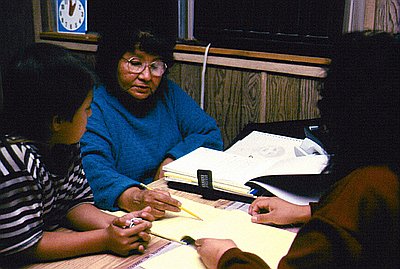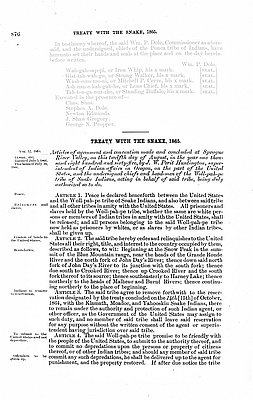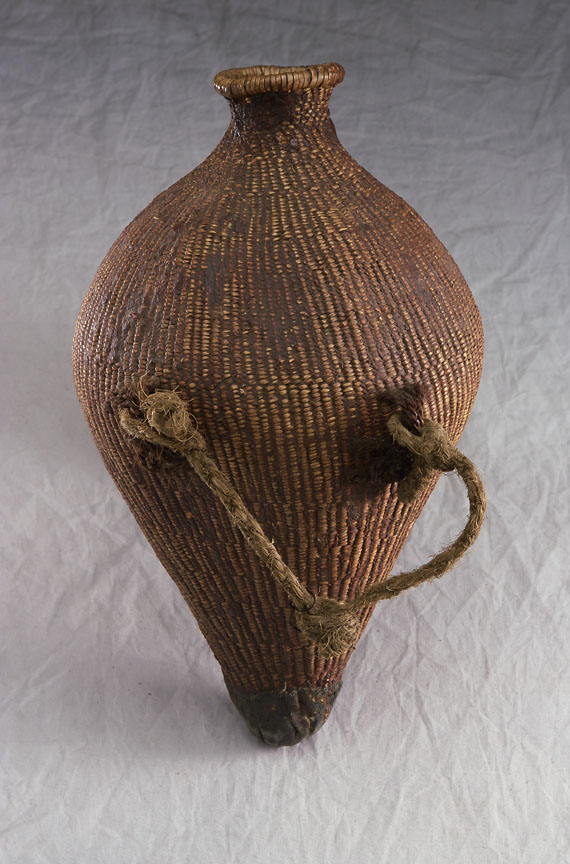- Catalog No. —
- OHS Mus 73-126.9
- Date —
- n.d.
- Era —
- Oregon Country before 1792
- Themes —
- Environment and Natural Resources
- Credits —
- Oregon Historical Society
- Regions —
- Southeast
- Author —
- Unknown
Paiute Water Basket
The Paiute peoples of the Great Basin are widely known for their basketry, a fine example of which is shown above. This basket, probably made in the nineteenth century, was used by the Paiute to carry and store water, a precious resource in the arid Great Basin country. It is in the collections of the Oregon Historical Society and is currently on display in the Experience Oregon exhibit.
The Native peoples of North America made use of three basic techniques for making baskets, plaiting, coiling, and twining. The most popular method in Oregon is twining, used to make the basket shown above. Twining involves wrapping and twisting two or more flexible horizontal elements—called wefts—around a set of vertical elements—called warps. Archaeologists have found twined basketry that is more than 9,000 years old in Oregon's Fort Rock area.
The body of the basket above is probably made of willow or sumac fibers. A native plant fiber was used to make the rope handle, which is attached to the basket by horsehair loops. This particular basket has also been repaired with a piece of denim at the bottom.
Tightly woven water baskets like this one would have been covered in clay and hot pitch to make them practically waterproof. Paiute water baskets came in a variety of shapes and sizes, though all were light and resilient. This basket is on the smaller end of the scale, but some water baskets could carry five gallons of water or more.
Shaped somewhat like a gourd, the basket was done in a traditional style. With a pointed bottom, a broad middle, and a narrow opening, traditional water baskets were designed not to spill when resting on their sides. As Paiute interacted with settlers and miners beginning in the mid-nineteenth century, however, the shape of their baskets changed. Some examples of nineteenth-century Paiute water baskets are shaped like the brown jugs miners carried with them, while others are modeled after the canteens in which soldiers carried their water.
Besides water baskets, the people of the Great Basin also made a wide variety of other basketry, including clothing, cradles, fish traps, mats, winnowing baskets, and general use burden baskets. Many of these items are still being produced and used by modern Paiute peoples.
Further Reading:
Connolly, Thomas J. “Prehistoric Basketry from the Fort Rock Basin and Vicinity.” In Archaeological Researches in the Northern Great Basin: Fort Rock Archaeology Since Cressman. Eugene, Oreg., 1994.
Fulkerson, Mary Lee, and Kathleen Curtis. Weavers of Tradition & Beauty: Basketmakers of the Great Basin. Reno, Nev., 1995.
Wheat, Margaret M. Survival Arts of the Primitive Paiutes. Reno, Nev., 1967.
Written by Cain Allen, © Oregon Historical Society, 2005.
Related Historical Records
-
Paiute Storytelling
This photograph of Myrtle Peck teaching the Paiute’s language and traditional stories to her children was taken by Leila Childs in 1997. At the time, the Pecks were participating in …

-
Treaty with the Snake (Northern Paiute), 1865
This treaty, dated August 12, 1865, is reprinted from the second volume of Charles Kappler’s Indian Affairs: Laws & Treaties, published in 1904. J.W. Perit Huntington, Oregon Superintendent of …

